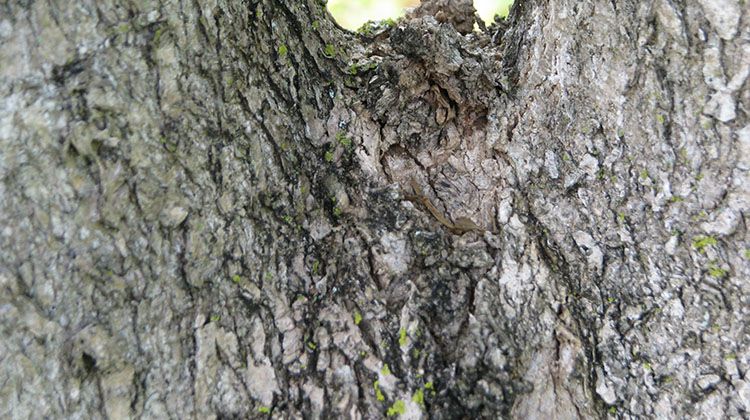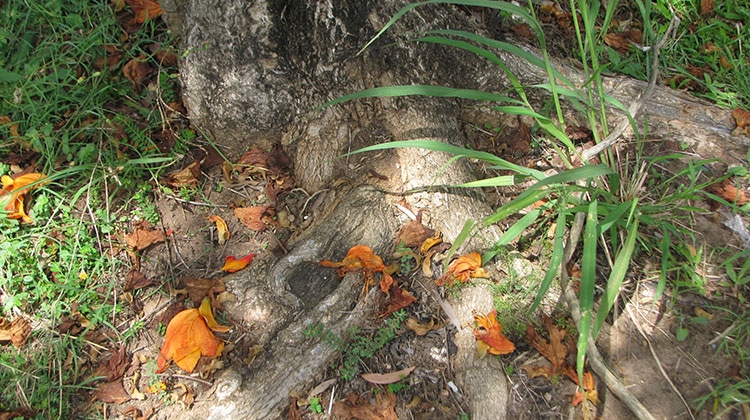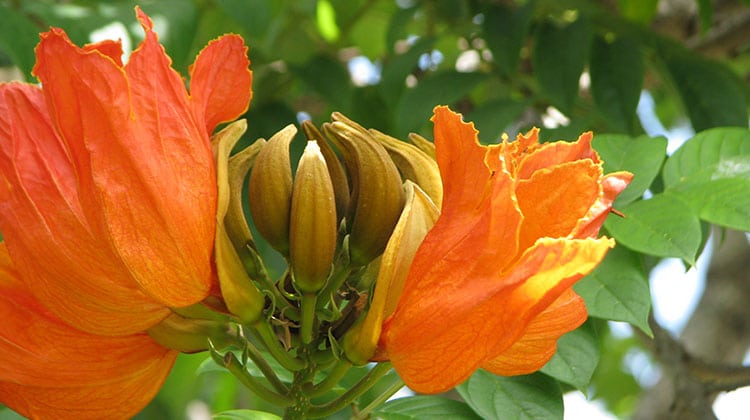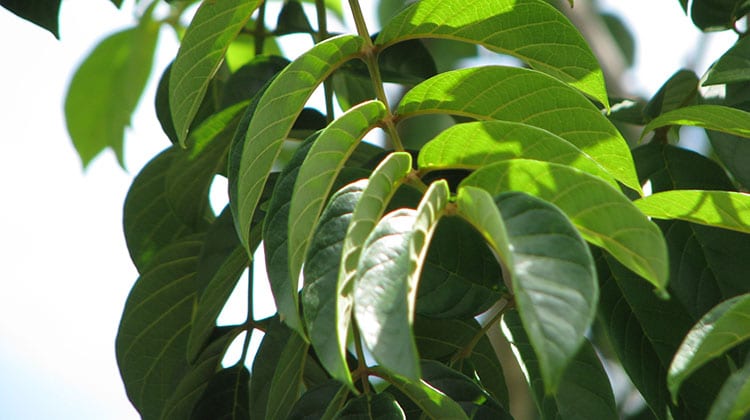Spathodea campanulata
Family: Bignoniaceae Origin: Native to the tropical, dry forests of Western Africa.
With their flaming red flowers, African Tulips Trees have been popularly used as ornamental plants, decorating the suburban streets and gardens of Australia’s tropical and subtropical regions.
However, they have become a serious, invasive threat in Northern Queensland and are beginning to impact upon Southern Queensland as well. African Tulip Trees are highly attractive to bees, birds, bats and butterflies that feed on the trees’ vast quantities of nectar. They establish easily, are fast growing and have multiple forms of self-propagation.
The trees flower profusely and begin doing so when they have achieved as little as 1 metre in height, even while indoors or planted in a container. They will not survive in cold climates and can drop leaves suddenly if temperatures fall below average.
Arboriculture
Growth form
African Tulip Trees are capable of growing up to 24 metres. They are an upright tree with a wide, spreading canopy and can crowd out other forms of vegetation if left unmanaged. A soft-wooded evergreen, they sometimes develop twisted or lopsided due to their various, easily broken branches.

Trunk
Very established trees will develop a slight buttressing at the base. The bark can be marked with small white lenticels.

Flowering
Dense clusters of large, inflorescent, scarlet-coloured flowers have made these trees a favourite for gardeners. The flowers appear after the trees’ distinctive horn-shaped calyx tubes split reveal 10-12cm long, slightly cup-shaped petals with soft ragged edges.

The flowers are spectacularly coloured with shades of brilliant red, tending to orange. The tree will flower throughout the year, with more intense coverings during the springtime peak season.
The trees are also decorated with 15-20cm long seedpods. These flattened, green capsules grow in clusters and turn reddish-brown before they open to spill around 500 winged, papery seeds each.
Foliage
Large, pinnate leaves measuring up to 50cm with a collection of 7-17 broad, oval leaflets per pinnate. Dense foliage, especially in the crown, which can stretch to over 12 metres across.
Fruits
The African Tulip Tree produces a woody fruit with a poisonous centre. It is said that as a traditional hunting methods Africans would boil the fruit and extract the plants’ toxins, which they then used to dress the tips of their arrows.
Management
Propagation
The wood is soft and branches that break from the trees during rain and storms readily establish themselves as new seedlings where they fall. The tree can be propagated from herbaceous cuttings or from dried seed if the pods have been protected from frost.
Stumps from these trees sprout root suckers so unwanted growth may appear if trees are not removed properly.
As the tree’s main method of spread is wind-dispersed seed, where practical, juvenile pods should be removed to prevent further reproduction.
Cultivation
Drought tolerant, they can grow in dry, tropical forests but prefer moist locations such as creek-laden gullies where watered, rich soil can be found. Sheltered ravines are the ultimate environment for African Tulip Trees where they spread to fill the landform. In sandy, coastal areas they tend not to reach full height and can be more easily managed.
Relatively easy to grow and quick to produce colour in the garden, they often start as an initial joy for home-owners but, depending on where they’re planted, can become a high-maintenance pest later on.
Most of the problems involve the messiness and ongoing clean-up requirements of keeping the tree. The flowers litter the ground, pods and branches fall, sudden leaf drops clog gutters and along with other nectar-loving fauna, the tree can bring ants.
Environmental status
When the nectar in African Tulips ferments in becomes toxic to Australian bees, killing them. Since native bees are an important pollinator of Australian native flora, African Tulips have a terrible impact on Australia native trees. African Tulips should not be propagated and should be removed completely from the Australian urban landscape.


Hi David, We have an old ATT, 25 to 30m tall. The leaves are turning brown, and it is shedding its leaves. Is this normal during this time of the year? There is a ATT down the road , which also has brown shrivelled leaves, but not as many as ours. Our tree always has dropped a fair amount of old branches and does not produce copious amount off flowers anymore.
Are these signs of a tree reaching its end of life, or signs of a tree disease, or hopefully just a normal seasonal occurence? Looking forward to your reply
Hi there, I requested council remove a few trees from the footpaths in my area. They called to let me know that they’re a protected species despite being detrimental to our eco system. Who would I contact to consider re-categorising the tree?
Rhea
Hi, my neighbour has a ATT growing at our fencline. Approx 60% or more is growing over my side of the fence. This tree dumps volumous amounts of leaves and flowers really impacting my property. I have approached the neighbours about getting this removed but met with attitude and resistance. The leaves and flowers end up in my pool and cause a lot of problems. Is there anything I can do to have this tree taken down?
Hi Stewart. Yes, under the neighborhood disputes (trees and dividing fences) act 2011, your neighbor can be forced to pay for the pruning of the tree. Give us a call if you would like help with the q-cat process.
I have an att in my yard. I have informed lcc that they can chop it down. I’m broke will LCC do it? I have also noticed maderia vine in the neighbours yards. I pull it out it’s such a pest. Cheers
Jayne
Hi David, I’m currently in my rental home in the wynnum manly area doing a clean up. I’m approx 400m as a Bird flies from my large local leagues club. In the last three weeks they too are doing renos and have demolished all the gum trees from their Carpark. Outside my neighbors yard is a large gum tree were it sounds like the leagues clubs lori’s now call home in the afternoon, it sounds like hundreds of rainbow lorikettes lol.
Anyway, until just now I had no idea that the African tulip tree was a pest until I googled mistery lorikette deaths. One sight said it was poisonous to them then other sights was just bee’s.
My question is that I have a very large ATT in close proximity to this large gum and I have been finding dead rainbow lorikettes under this gum. In the 20 years I lived here I’ve never had one other than the odd car collision. These dead birds are within meters of both trees and look perfect (besides being dead) I’ve had another two dead today,
I ironically breed rainbow lorikettes up north and would hate to think my tree is coursing their deaths.
Is this African tulip tree killing these beautiful birds?
If not, any ideas as this isn’t normal.
Note….. I didn’t plant it 🙁
Regards
Jacquii
Lorikeets in my opinion are just flying rats. They chase away other birds we would rather have around such as king parrots, pale headed Rosella. They are insanely noisy in their large groups, droppings everywhere, they are just a bit if a nuisance,
Hi Frankie. We do mean bees. The flowers are toxic to Australian native bees (and other insects) for the first few days they are open. Thanks for commenting, David.
Hi David, I have two African Tulip trees on my property in norther Brisbane, and they are a truly beautiful tree with lovely flowers. Unfortunately, I will be removing them in the next couple of because of the native bee issue. There are so many native bees around, and they don’t stand a chance when they enter the flower. There is evidence of dead bees inside the flowers when they drop to the ground.
Well noticed, Bernard. I’ve examined African Tulip tree flowers on many occasions and confirmed for myself their toxicity to bees.
HI David
I have an African Tulip Tree growing beautifully beside my garage. My new neighbour asked me a few weeks ago if he could cut down two branches that overhang his pool. I had no problem with that though also, did tell him that I was planning to have it chopped out anyway.
I do want to chop it out, despite the beautiful coloured flowers, however; I would like to use an organic poison that will be non toxic to the rest of my garden.
Looking forward to hearing from you Julie G
Hi Julie. I suggest solarization. Wrap black plastic over the stump and the heat will kill the stump over time while not permitting new shoots to grow.
To David, my Chinese investor neighbour three years ago cut down all the trees in his garden. Behind our fence he had one Tulip tree. This was also cut down. Now instead of one tulip tree, up to 10 tulip trees have sprouted up. The investor rents the house to people who don’t care about the garden and he also doesn’t care. the Council cannot do anything about these trees. Can you pose tell me what the root system may do to our pool which is close to the fence line in our garden
Hi Ineke. Please phone me and I will assist you. The Neighbourhood Disputes Act (Trees and Dividing Fences) 2011 in addition to the Biosecurity Act 2014 may be relevant to your problem.
I can assess the impact of roots on your pool only after taking measurements. However, due to the species being an environmental weed it’s likely I can help you have the trees removed regardless of the potential impact of the roots.
Council have a African Tulip outside my home, the roots have damaged my bathroom floor, my stormwater drains and now my sewer lines and Brisbane City Council refuse to remove it, This tree has cost me a lot of money however that is no concern to BCC. Any suggestions ?
Hi Phillip. I find BCC most reasonable and helpful. Please contact me to discuss an assessment.. The council appreciates issues like this being documented before moving forward to action.
I would like to remove the full grown African T T from my yard . Just now it has lost all of its leaves (?). We loved it but did not know about bees and environmental issues. We will kill the stump with the plastic technique as many bird feeder trees are under it. As it is a weed can BCC assist with chopping it down? We are pensioners the expense of removing it is too much . Carol
David , I have read through the comments here and also want to remove a giant African Tulip that I suspect the roots of are undermining my house and concrete outdoor area , can you tell me how far and how deep the roots usually are , i note it looks to have surface roots visible about 4-5mts away from it , how can I apply for any assistance with BCC to have it removed ?, there is also a 90 yrs old Mango on the opposite side of the yard …..but I suspect it is not the main problem to my house .. ?? is the root system of the Mango deeper , larger than the Tulip ?? … they are both huge trees ..I do like the shade from the Tulip but I dont like the possible future cost $$ of repairs to my house , any assistance or advice is very welcome , cheers Rick in Annerley